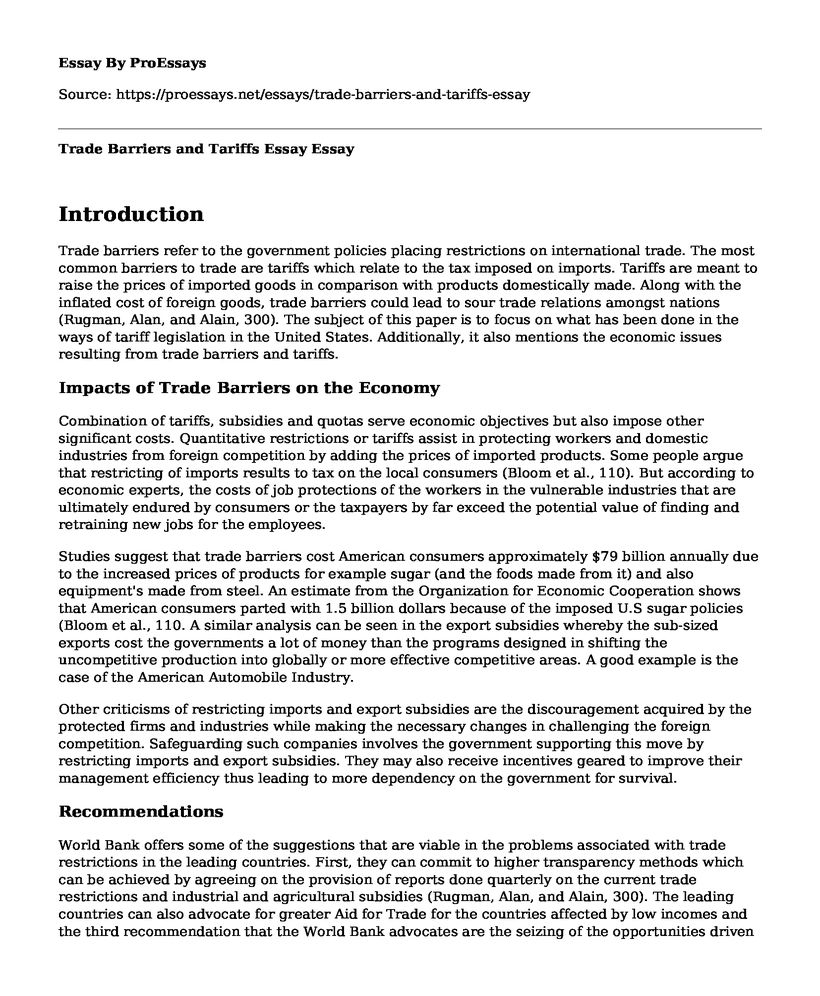Introduction
Trade barriers refer to the government policies placing restrictions on international trade. The most common barriers to trade are tariffs which relate to the tax imposed on imports. Tariffs are meant to raise the prices of imported goods in comparison with products domestically made. Along with the inflated cost of foreign goods, trade barriers could lead to sour trade relations amongst nations (Rugman, Alan, and Alain, 300). The subject of this paper is to focus on what has been done in the ways of tariff legislation in the United States. Additionally, it also mentions the economic issues resulting from trade barriers and tariffs.
Impacts of Trade Barriers on the Economy
Combination of tariffs, subsidies and quotas serve economic objectives but also impose other significant costs. Quantitative restrictions or tariffs assist in protecting workers and domestic industries from foreign competition by adding the prices of imported products. Some people argue that restricting of imports results to tax on the local consumers (Bloom et al., 110). But according to economic experts, the costs of job protections of the workers in the vulnerable industries that are ultimately endured by consumers or the taxpayers by far exceed the potential value of finding and retraining new jobs for the employees.
Studies suggest that trade barriers cost American consumers approximately $79 billion annually due to the increased prices of products for example sugar (and the foods made from it) and also equipment's made from steel. An estimate from the Organization for Economic Cooperation shows that American consumers parted with 1.5 billion dollars because of the imposed U.S sugar policies (Bloom et al., 110. A similar analysis can be seen in the export subsidies whereby the sub-sized exports cost the governments a lot of money than the programs designed in shifting the uncompetitive production into globally or more effective competitive areas. A good example is the case of the American Automobile Industry.
Other criticisms of restricting imports and export subsidies are the discouragement acquired by the protected firms and industries while making the necessary changes in challenging the foreign competition. Safeguarding such companies involves the government supporting this move by restricting imports and export subsidies. They may also receive incentives geared to improve their management efficiency thus leading to more dependency on the government for survival.
Recommendations
World Bank offers some of the suggestions that are viable in the problems associated with trade restrictions in the leading countries. First, they can commit to higher transparency methods which can be achieved by agreeing on the provision of reports done quarterly on the current trade restrictions and industrial and agricultural subsidies (Rugman, Alan, and Alain, 300). The leading countries can also advocate for greater Aid for Trade for the countries affected by low incomes and the third recommendation that the World Bank advocates are the seizing of the opportunities driven in support of global trade in times of desperation that is when it urgently needs help.
Conclusion
In conclusion, trade restrictions do more harm than good and are the primary impediments in the development efforts. Various developing nations are not able to sell their products globally due to the high imposed quotas and tariffs. In addition to this, the domestic markets begin to flood with the sub-sized, cheaper products acquired from abroad. The developed nations hence continue getting more productive as the developing ones left to struggle economically. In response to these identified problems concerning the trade restrictions, the World Bank has come up with some of the suggestions that could help the leading countries.
Works Cited
Bloom, Nicholas, Mirko Draca, and John Van Reenen. "Trade induced technical change? The impact of Chinese imports on innovation, IT and productivity." The Review of Economic Studies 83.1 (2016): 87-117.
Rugman, Alan, and Alain Verbeke. Global corporate strategy and trade policy. Routledge, 2017.
Cite this page
Trade Barriers and Tariffs Essay. (2022, May 17). Retrieved from https://proessays.net/essays/trade-barriers-and-tariffs-essay
If you are the original author of this essay and no longer wish to have it published on the ProEssays website, please click below to request its removal:
- Paper Example on Google's Business Model
- Employability Skills for New Graduates - Annotated Bibliography
- The Global Economic World: A Look at Globalization - Essay Sample
- Essay Example on Globalization: Good or Bad? Reasons & Understandings
- Retail Mgmt E-Commerce: Strategic Planning for Continuous Comp. Adv - Essay Sample
- Globalization & Talent Retention: Challenges in Education - Essay Sample
- Japanese Yen Crisis - Research Paper Sample







